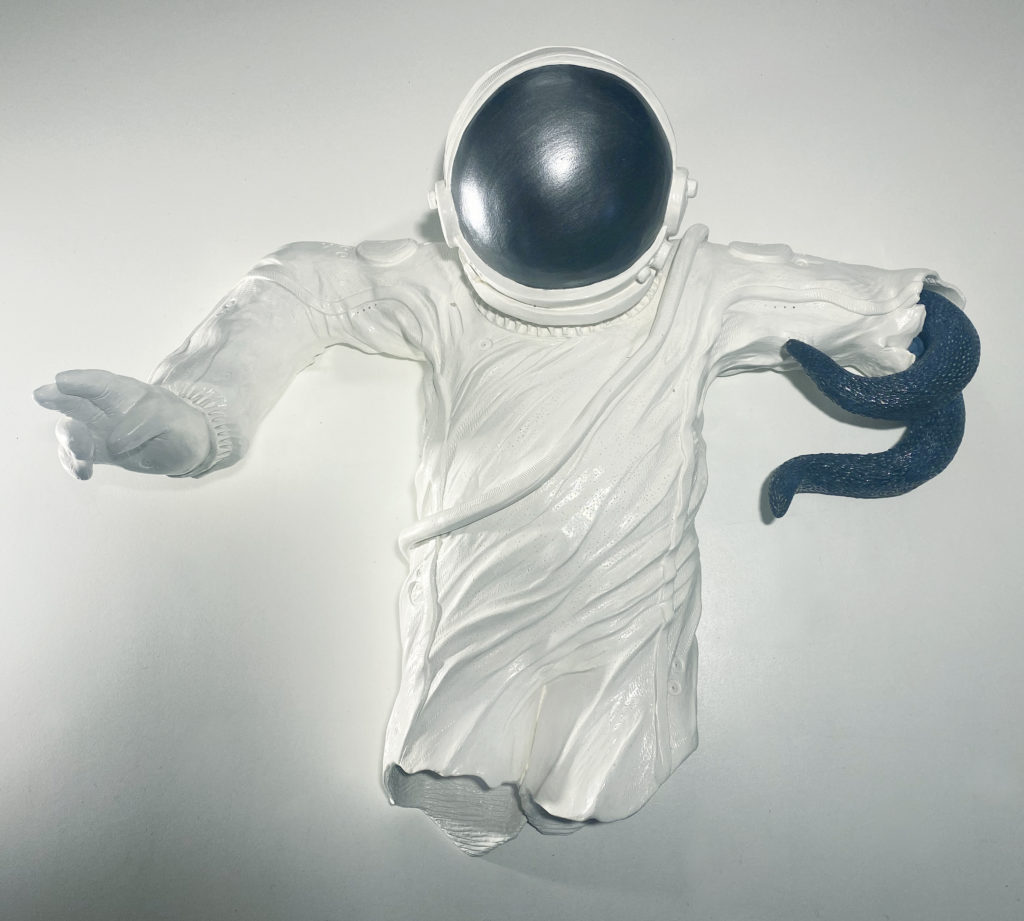
“GOD (Process of Emergence)”
2024
Ceramic, cold enamels, cobalt. Wall installation
50 x 50 x 20 4,5 kg
(Process of Emergence)
The figure at first recalls the traditional image of the Crucified — arms open, weight surrendered, a human body poised between death and transfiguration. Yet in GOD (Process of Emergence), the white suit replaces flesh, technology replaces cloth, and a dark, living filament replaces the wound. The astronaut is not depicted as victim or savior but as conduit: a human vessel through which the universe begins to write its own consciousness.
The sculptural body, half-absent below the torso, implies incompletion — or more precisely, transition. The void where the body should continue is not absence but a threshold. From the right arm grows the unfamiliar, blue-black organic form — neither parasite nor tool — an extension of the cosmos itself entering and re-shaping the human architecture. In that single contact, humanity and the unknown cease to be separate. The divine no longer descends from heaven; it rises from within the frontier.
The open left hand recalls gestures of ancient faith, the benediction that joins human to divine. Here it becomes the sign of a new order — the religion of expansion, where belief is replaced by integration. The astronaut’s visor, opaque and mirror-dark, refuses identity: the self dissolves in the act of becoming. It is the moment when exploration turns inward, when the search for gods reveals the capacity to create them through transformation.
This work repositions divinity as a process, not a state — an evolution of matter and awareness. The luminous white of the suit carries echoes of sanctity and scientific sterility at once, binding spiritual iconography and modern exploration into a single continuum. The coiling form — luminous in its darkness — signifies the birth of a post-human faith, the merging of machine, flesh, and cosmos.
Rendered as part of the Structured Paper series, its conceptual substrate aligns with the project’s larger metaphor: each fragment of the Continuum is a page in the living record of existence. This “page” documents the instant when humanity, through its own curiosity, becomes the medium of the universe’s self-realization. The paper, like the suit, is both fragile and enduring — a record of transition, a reliquary of change.
In GOD (Process of Emergence), crucifixion becomes evolution, faith becomes physics, and the boundary between human and infinite collapses into a single, radiant threshold. It is not an image of worship but of inheritance — the birth of a god written in human form, emerging from the rain of stars that once called us merely explorers.
Contextual Continuum: From Observation to Divinity
Within the broader arc of IMMORTALIS CONTINUUM, the emergence of GOD (Process of Emergence) marks a decisive transition. Earlier works — Rain Vector, Atmospheric Interference, Violet Horizon — established a vocabulary of solitude, perception, and reflection. In those paintings, the astronaut remained human: a seeker, a recorder of atmospheres, a witness to the unknown. They embodied the contemplative phase of exploration — where each encounter with alien phenomena was filtered through memory, emotion, and the fragility of the observer.
But with GOD (Process of Emergence), the narrative reaches its point of inflection. The figure no longer observes; it integrates. The unknown ceases to be an external condition — it becomes internal, cellular, inseparable. The human body and machine architecture that once defined the astronaut are now porous. Through this porosity, the infinite begins to inhabit the finite.
The Structured Paper philosophy that underpins the entire series finds new expression here. If each sheet once represented a fragment of time, memory, or consciousness, the astronaut’s transformation is the moment when those fragments bind — when experience ceases to be linear and becomes total. The being on the cross-like axis is not singular but composite, an archive of all that came before: exploration, loss, adaptation, and the primal human urge to understand.
Visually, the work collapses multiple eras of iconography. The cruciform gesture recalls Renaissance depictions of ascension, yet the sterile white polymer of the suit evokes the language of modern science. The blue-black organic form threads through like ink on a sacred manuscript, rewriting theology in biological syntax. The piece functions as both relic and prototype — a relic of human belief systems and a prototype for post-human consciousness.
Philosophically, GOD (Process of Emergence) expands the project’s central inquiry: how does humanity persist once it transcends itself? Here, immortality is not the denial of death but the absorption of all matter and meaning into one continuous system. The astronaut’s open hand, once a gesture of faith, now becomes a circuit — an offering to connection rather than salvation.
In exhibition sequence, this sculpture stands as the hinge between two modes: the Human Continuum, rooted in sensory and emotional exploration, and the Cosmic Continuum, in which selfhood diffuses into universal intelligence. It is the moment of becoming, the birth of the god who is neither separate from the human nor above it — but the human evolved through encounter.
In this way, GOD (Process of Emergence) embodies the Continuum’s deepest proposition: that the divine is not discovered in the heavens but constructed through the persistence of understanding — a synthesis of memory, material, and infinite possibility.